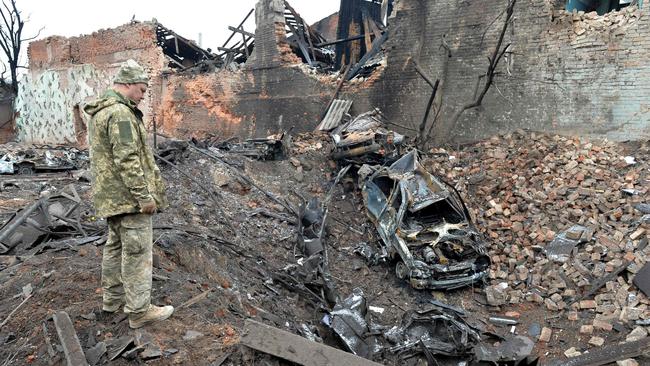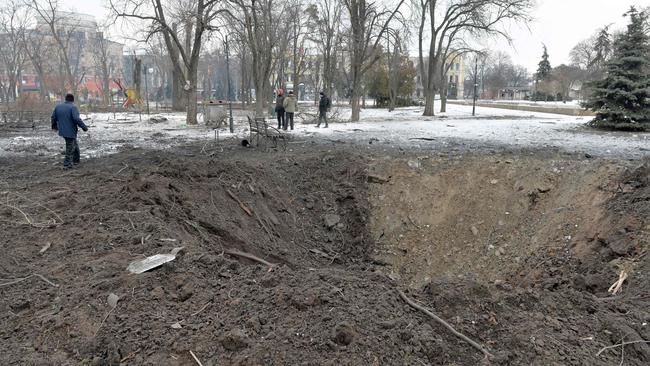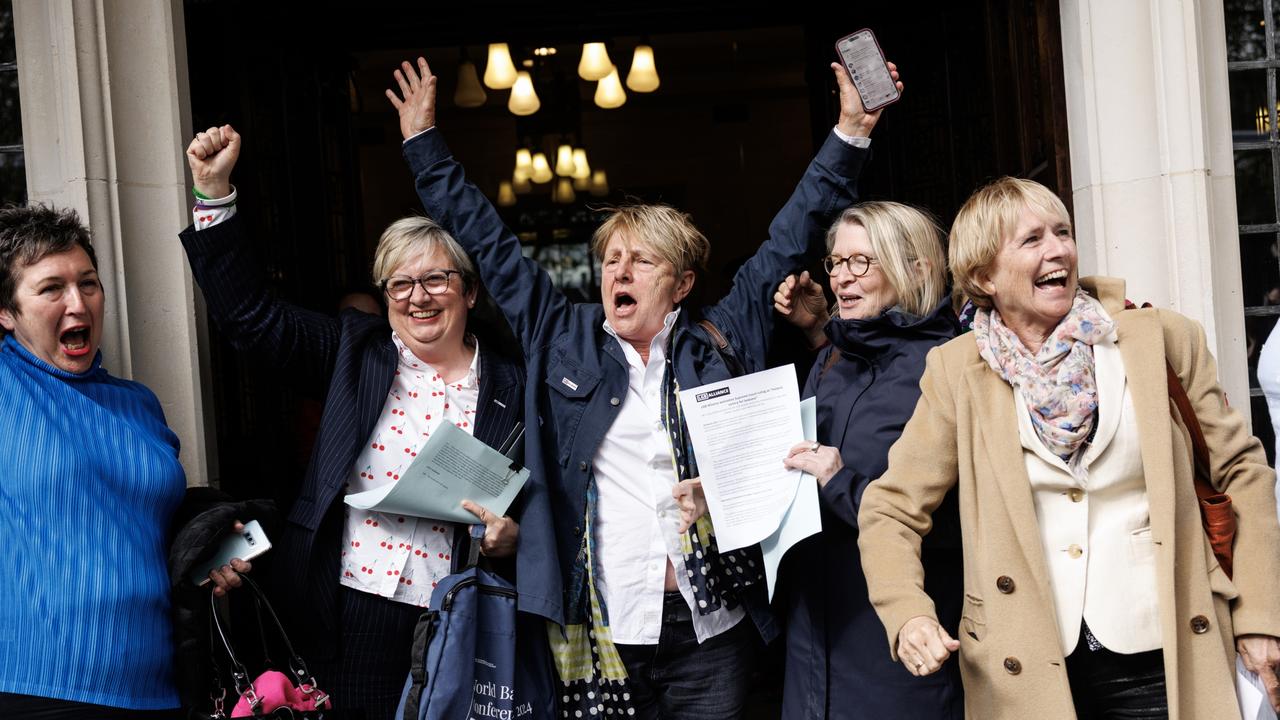Kharkiv’s hospitals reveal the hideous cost of Putin’s invasion
In Kharkiv, the faces of war are sculpted by flying glass and burning shrapnel.

In Kharkiv’s hospitals, the faces of war are sculpted by flying glass and burning shrapnel. Women are adorned with stitches, their skin coloured by bruises and garish green disinfectant. Wounded children stare up from their hospital beds, listless with pain and trauma. Some weep in shock.
Artillery fire and the roar of jets overhead rattle the windows, so fear follows patients as their injuries are treated by exhausted medical staff working back-to-back shifts.
Better than any military map, their chopped skin and ripped flesh charts the progress of the Russian campaign in Ukraine’s second city, under assault from airstrikes, surface-to-surface missiles and artillery fire as the Kremlin’s operation to seize Kharkiv spirals from military thrust into punitive bombardment.
“We’re just waiting for Putin to come to Kharkiv’s streets to discuss how much his army is making an effort to avoid killing civilians,” spat Irena Sydorenko, 35. She was lying in a hospital in the north of the city with shrapnel injuries and a severely injured pelvis after a Russian rocket detonated under her fifth-floor apartment in the Saltivka district three days ago. “Come and check on us here, Vladimir Putin, and see how accurate your artillery is.”
Her husband, Dimitri, sat on a bed to her right, his head wrapped in bandages, and to her left her 15-year-old daughter Valeriya wept as artillery fire rumbled across the city. The family were blown down a corridor in their home by the blast. They grabbed one another, assuming they had survived the worst, only for the floor to give way beneath them as the building began to collapse. They fell two floors in a heap of burning rubble before volunteers pulled them clear. Minutes later, the roof collapsed. Ten people died.
In the next room Dima Zadoroznyi, 41, a painter and decorator, lay looking at where his right leg used to be. He had been walking down the street three days ago when several simultaneous explosions, possibly from a cluster bomb, blew him to the floor. He tried to get up, but in vain.
“Then I saw a leg lying on the tarmac in front of me. It had my shoe on,” he shrugged. “That was it. I might be able to lie here thinking that some day I’ll get a prosthesis and walk and work again, but all I hear is artillery outside, and the thought of my immediate future is terrifying. I am wondering more whether I shall live than whether I will walk again.”
Mr Zadoroznyi was not alone in dealing with the grotesque shock of life-changing injury. In a central Kharkiv hospital, where doctors requested that the names of facilities visited by The Times be withheld for security reasons, Yelena Bolyachenko, 55, a sales manager, described being blown to the wall of her home in a cyclone of glass and shrapnel when her apartment was hit by a Russian shell three nights ago.
“I crawled around unable to see, my head covered in blood, and felt my face full of gaping holes,” she said.
“Eventually I found a towel and mopped away the blood, hoping I’d be able to see. But I can’t. I’ve been completely blinded in one eye and can no longer see properly in the other. The doctors cannot tell me if I’ll ever get even 50 per cent of my sight back.”
The Russian offensive on Kharkiv, once the capital of Ukraine, changed a week ago after a push by a lightly armoured column into the north of the city was routed by Ukrainian troops. Despite assurances from the Russian Defence Ministry that its forces would not target civilian infrastructure, retribution for the Russian failure was swift. A week ago, a barrage of Grad rockets landed around the regional administration building on Freedom Square. Since then artillery and rocket fire have savaged residential areas in the north, east and south of the city.
On Sunday, during a total blackout, Russian jets roared low overhead, bombing targets that lit the darkness in fireballs. Buildings shook with the explosions. A loud detonation in the sky suggested that at least one jet had been hit by anti-aircraft fire as it swung away from its target, and soon afterwards a video recorded by Ukrainian activists showed a burning aircraft plunging to the ground.
The following morning I saw two victims of the bombs, a teenage boy and a 44-year-old woman, in a resuscitation unit. Appallingly wounded, both were in comas and the doctors treating them knew neither their names nor whether they were related.
In another ward, nurses rushed a man through a corridor on a trolley. “His wife is dead on the scene – both her legs gone,” a doctor said as an exhausted colleague burst into tears while describing the delivery of a baby, in the roar of heavy artillery fire and by the light of a mobile phone.
Artillery fire and the blasts of Grad rockets continued throughout the day, leaving roads into the city littered with rubble and shredded trees. Beside a shell-hit residential block in the western quarter a rocket protruded from the kerb. Near by was a crater three metres deep, left by another missile.

Thousands of residents now live a subterranean existence in bomb shelters and the underground Metro system, emerging during breaks in the shelling to gather whatever possessions they can from their homes.
In an underground railway station in Saltivka district, I saw hundreds of civilians lying shoulder to shoulder on platforms, or sleeping in stationary carriages. They were shocked and afraid, and the perpetual echoing of Covid-19 coughs in the dense crowd added to their misery.
“We never even saw a soldier or tank near my apartment block. We were just caught between two invisible armies,” said Natalia, 55, who was sheltering with her family of seven. “Shells flew everywhere, smashing our homes and killing those around us.
“See us here! Babies, children, the young, the old, rich and poor, those whose homes are destroyed or those who are too frightened to go home. Once we hoped it would soon stop. Now we feel it will continue until the whole city is destroyed. We beg you to help us.”
In the chaos of the war and with the breakdown of central accounting systems, statistics for civilian deaths are impossible to verify. But in two hospitals in Kharkiv, visited by The Times in the past 48 hours, medical staff who have been sleeping at work for four hours a night between rolling shifts described treating “hundreds” of people over the past week.
“I’ve had more than 100 wounded civilians arrive in my ward since the shelling of the city began, and that’s just one ward in one hospital,” said Vladislav Palamarchuk, the head of a trauma ward in a hospital in the north of the city. “Almost every one of them was wounded by airstrikes or artillery. Other wards have had more, and other hospitals have had it worse.”
Flying shrapnel does not discriminate. Artem, 10, lay in the corridor outside Dr Palamarchuk’s office, clasping a lump of shrapnel. It was removed from his left thigh after he was wounded by a shell three days ago. A glowing rage flickered behind the boy’s staring eyes. “I know why Vladimir Putin shelled my home and hurt me,” Artem said. “It’s because he is a dog and a bandit.”
Even among the pain and fear, the bloody wounds and the unending crash of shellfire, there was a place for stoicism and dark humour. Oleg Ilchinskyi, 54, and his wife, Victoria, 47, both lawyers, talked about having lunch at their kitchen table four days ago.
They had just opened a bottle of Italian wine when a rocket destroyed their apartment around them, wounding them both with a wave of glass and shrapnel.
“The balcony disappeared in an instant, torn away. The windows blew in upon us in a storm of blast and heat,” she said. “The furniture blew to smithereens as we smashed into the fridge, which joined us rolling down the corridor, covered in blood. Amid it all, the bottle of red stood untouched. I’ll never forget that weird detail.”
Minutes after the blast, as they staggered from the ruins of their home and collapsed into the arms of rescuers, Victoria’s phone rang. It was the couple’s 15-year-old daughter, calling from Brussels to check that they were all right.
“So I took the call covered in blood in the street, our home obliterated behind us, dust and smoke everywhere, glass sticking out of my skin, barely able to stand. I took a deep breath, gathered myself and said, ‘Don’t worry darling, everything is just fine here’.”
THE TIMES



To join the conversation, please log in. Don't have an account? Register
Join the conversation, you are commenting as Logout